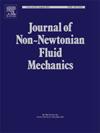粘弹性流动特性的数值研究:Giesekus流体通过靠近平壁面的圆柱
IF 2.8
2区 工程技术
Q2 MECHANICS
引用次数: 0
摘要
本研究采用OpenFOAM中的Giesekus模型,对靠近平壁面的圆柱体周围的粘弹性流动动力学进行了数值研究。对于平面壁面上的边界层,弹性和剪切减薄特性都降低了边界层厚度。通过系统参数分析了吉塞库斯流体绕近壁圆柱流动的弹性耦合和剪切减薄效应。在高迁移系数下,增加Weissenberg数主要增强剪切减薄效应,导致阻力和升力波动加剧。而在低迁移系数时,主要是增强弹性效应,表现为尾迹再循环区的伸长。利用Carcarau模型的对比模拟进一步揭示了弹性稳定与剪切减薄失稳的竞争流动机制。除了流体性质参数外,较小的间隙比通过保持较低的间隙流速来增强流动稳定性。相反,较大的间隙比会增加速度,使高动量流体通过间隙偏转并与气缸上部尾迹形成的剪切层相互作用,从而引发旋涡脱落。同样,减小流动发展长度会加速间隙内的流动速度,使板壁边界层变薄,从而加剧流动的不稳定性。较大的间隙比和较短的发展长度都会增加阻力并改变升力方向。本文章由计算机程序翻译,如有差异,请以英文原文为准。
Numerical investigation of viscoelastic flow characteristics: Giesekus fluid past a circular cylinder near a flat wall
This study numerically investigates viscoelastic flow dynamics around a cylinder near a flat wall using the Giesekus model in OpenFOAM. For the boundary layer on the flat wall, both elastic and shear-thinning properties reduce boundary layer thickness. The coupled elastic and shear-thinning effects of the Giesekus fluid flow around the near-walled cylinders are analyzed through systematic parameters. At high mobility factor, increasing the Weissenberg number primarily enhances the shear-thinning effect, leading to intensified drag and lift fluctuations. However, at low mobility factor, it mainly strengthens the elastic effect, evidenced by the elongation of recirculation zone in the wake. The comparative simulations using the Carcarau model further reveal the competing flow mechanisms between flow stabilization due to elasticity and destabilization caused by shear thinning. In addition to the fluid property parameters, smaller gap ratios enhance flow stability by maintaining lower flow velocity in the gap. Conversely, larger gap ratios increase the velocity, causing high-momentum fluid flow through the gap to deflect and interact with the shear layer formed by the cylinder’s upper wake, thereby triggering vortex shedding. Similarly, a reduced flow development length accelerates the flow velocity in the gap and thins the boundary layer of the plat wall, which promotes flow instability. Both larger gap ratios and shorter development lengths increase the drag and alter the lift direction.
求助全文
通过发布文献求助,成功后即可免费获取论文全文。
去求助
来源期刊
CiteScore
5.00
自引率
19.40%
发文量
109
审稿时长
61 days
期刊介绍:
The Journal of Non-Newtonian Fluid Mechanics publishes research on flowing soft matter systems. Submissions in all areas of flowing complex fluids are welcomed, including polymer melts and solutions, suspensions, colloids, surfactant solutions, biological fluids, gels, liquid crystals and granular materials. Flow problems relevant to microfluidics, lab-on-a-chip, nanofluidics, biological flows, geophysical flows, industrial processes and other applications are of interest.
Subjects considered suitable for the journal include the following (not necessarily in order of importance):
Theoretical, computational and experimental studies of naturally or technologically relevant flow problems where the non-Newtonian nature of the fluid is important in determining the character of the flow. We seek in particular studies that lend mechanistic insight into flow behavior in complex fluids or highlight flow phenomena unique to complex fluids. Examples include
Instabilities, unsteady and turbulent or chaotic flow characteristics in non-Newtonian fluids,
Multiphase flows involving complex fluids,
Problems involving transport phenomena such as heat and mass transfer and mixing, to the extent that the non-Newtonian flow behavior is central to the transport phenomena,
Novel flow situations that suggest the need for further theoretical study,
Practical situations of flow that are in need of systematic theoretical and experimental research. Such issues and developments commonly arise, for example, in the polymer processing, petroleum, pharmaceutical, biomedical and consumer product industries.

 求助内容:
求助内容: 应助结果提醒方式:
应助结果提醒方式:


